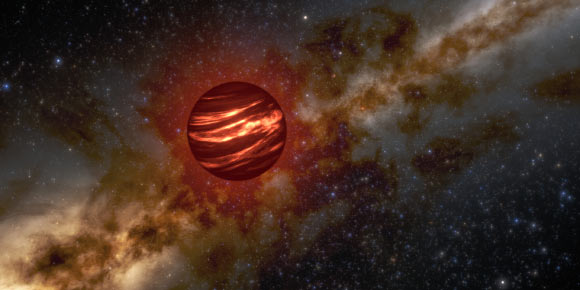Using data gathered by NSF’s Gemini South telescope and the NASA/ESA/CSA James Webb Space Telescope, astronomers have detected signatures of methane (CH4), water (H2O) and silane (SiH4) gas on the cold brown dwarf WISEA J153429.75-104303.3 (W1534 for short). Although silane is expected to serve as a key reservoir for the cloud-forming element silicon in gas giant worlds, it has remained undetected until now because it is removed from observable atmospheres by the formation of silicate clouds at depth.

This artist’s illustration shows a brown dwarf that hosts an atmosphere filled with gas and dust clouds. Image credit: NOIRLab / NSF / AURA / R. Proctor.
Nicknamed The Accident, W1534 is located about 50 light-years away from Earth in the constellation of Libra.
This brown dwarf likely formed 10-12 billion years ago, making it one of the oldest brown dwarfs ever discovered.
The object was first spotted in 2020 by a citizen scientist participating in the Backyard Worlds: Planet 9 citizen science project.
Its strange light profile piqued the interest of astronomers, so they turned to two of the world’s most powerful ground- and space-based telescopes to peer into its atmosphere and better understand its nature and composition.
The investigation began with NSF’s NOIRLab astronomer Sandy Leggett obtaining near-infrared images of W1534 using the Gemini South telescope in Chile, one half of the International Gemini Observatory.
This laid the groundwork for further investigations, led by NOIRLab astronomer Aaron Meisner, using Webb.
“W1534 is extremely faint, and Gemini South remains the only ground-based telescope that’s so far been able to detect it,” Dr. Meisner said.
“The Gemini detection set the stage for observations with Webb by allowing us to estimate the exposure time we would need to probe this enigmatic object’s deep atmospheric layers and get useful near-infrared data about its composition.”
In W1534’s atmosphere, the team found a conclusive signature of the chemical silane — silicon bonded with four hydrogen atoms.
Planetary scientists have long predicted that this molecule exists in gas giants and that it plays an important role in the formation of clouds within their atmospheres.
Despite decades of searching, it eluded detection in the atmospheres of our Solar System’s gas giants, Jupiter and Saturn, as well as the thousands of atmospheres scientists have studied on brown dwarfs and gas giants around other stars.
This marks the first discovery of silane in any brown dwarf, exoplanet, or solar system object.
The fact that this molecule hasn’t been detected anywhere except in a single, peculiar brown dwarf suggests something about the chemistry occurring in such ancient environments.
“Sometimes it’s the extreme objects that help us understand what’s happening in the average ones,” said Dr. Jackie Faherty, a researcher at the American Museum of Natural History.
The presence of silane in W153’s atmosphere suggests that, in very old objects, silicon can bond with hydrogen to form a light molecule that can reach the upper layers of a gas giant’s atmosphere.
But in objects that formed more recently, like Jupiter and Saturn, the silicon bonds with the more readily available oxygen, creating heavier molecules that sink deep below the surface layers of the atmosphere, where they are undetectable by our telescopes.
The evidence uncovered in W153’s atmosphere confirms astronomers’ understanding of how clouds on gas giants form, and offers critical insight into how primordial formation can impact the composition of a planet’s atmosphere.
Additionally, it reveals how a world formed billions of years ago can look drastically different than a world formed during the dawn of our Solar System.
“The formation and detection of silane demonstrates key coupled relationships between composition, cloud formation and atmospheric mixing in cold brown dwarf and planetary atmospheres,” the authors concluded.
Their paper was published in the journal Nature.
_____
J.K. Faherty et al. 2025. Silicate precursor silane detected in cold low-metallicity brown dwarf. Nature 645, 62-66; doi: 10.1038/s41586-025-09369-1







